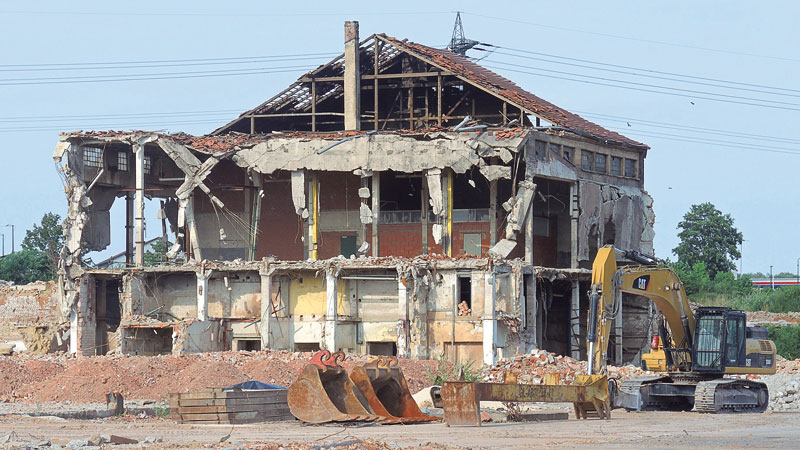Construction waste poses a great danger to the environment. For this reason, construction industries need to find suitable methods to manage construction and demolition materials that generate waste during construction activities. Using trash chutes to get waste out of the site is one good way of safe waste disposal.
Construction and demolition materials consist of debris that is generated during construction, renovation, and demolition of buildings, roads, and bridges. Heavy and bulky materials like the following are some examples of construction and demolition materials:
- Concrete
- Wood
- Asphalt
- Metals
- Bricks
- Glass
- Rocks
Benefits of reducing disposal of C&D materials
- Employment creation and an increase in economic activities in recycling industries. This will also increase the business opportunities within the local community, in areas where deconstruction and selective demolition are used.
- Reduction in overall building project expenses through avoided purchase costs and donation of recovered materials to qualified charities, which offers a tax benefit. Transportation costs also come down with onsite material reuse.
- Fewer disposal facilities which reduce associated environmental issues.
- Conserve landfill space.
- The environmental impact associated with the extraction and consumption of virgin resources and the production of new materials is offset.
Reduce, Divert and reuse and Recycle C&D Materials
You can help divert construction and demolition materials from disposal by practicing source reduction, salvaging, recycling, and reusing existing materials. You can also buy used and recycled products and materials.
1. Reduce
With source reduction, you can reduce the life-cycle of material use, energy use, and waste generation. The highest priority should be given to address solid waste issues. Source reduction prevents waste from being generated in the first place. Some examples of this include – preserving existing buildings rather than constructing new ones, optimizing the size of new buildings, designing new buildings for adaptability to prolong their life, use of construction methods that allow disassembly and facilitate reuse of materials, and employing alternative framing techniques. Reducing construction and demolition debris also conserves landfill space, reduces the environmental impact of producing new materials, and can cut down the overall building project expenses through avoided purchase.
2. Divert and Reuse
Raw construction and demolition debris can be diverted and used as a resource. Some materials that can be diverted include:
- Landscape and land clearing debris
- Asphalt pavements
- Gravel and aggregate products
- Concrete
- Masonry scrap and rubble
- Clean wood
- Plastics
- Insulation materials
Recovering used but valuable construction and demolition materials for further use is an effective use to save money and conserve natural resources. Deconstruction can be used at a number of levels to salvage usable materials and significantly cut waste. It has the following benefits:
- Maximizes the recovery of materials
- Conserves finite forest resources
- Provides employment opportunities
- Allows communities to create local economic activities around manufacturing or reprocessing salvaged materials
- Diverts demolition debris bound for disposal
3. Recycle
Many building components and construction debris can be recycled. Concrete and rubble are often recycled into aggregate and concrete products. Wood can be recycled into engineered wood products like furniture. Metals like steel, copper, and brass are also valuable resources to recycle.
There are three methods for waste recycling:
- Site-separated: This uses multiple boxes for each type of waste. Separating construction waste on the job site gives immediate feedback to everyone on the job and can help to ensure that the project’s recycling goals are met. Site separation also promotes a responsible atmosphere on the job site and is the best method for diversion goals. It does, however, take up more space and requires a high level of supervision.
- Commingled recycling : This type of recycling uses one container. The hauler sorts everything off-site. This makes it easier for the field staff to manage waste on-site. Commingled recycling requires little storage space and is the best option for sites that are tight on space.
- Hybrid recycling : This type of recycling combines site-separation and commingled recycling. For instance, one box for wood, one box for concrete, and one box for non-recyclable waste. Hybrid recycling represents the best of both worlds. It optimizes the weight vs. sorting effort. The total number of boxes can be reduced by working in phases. It reduces work for sorting haulers, which reduces hauling fees.
For each project, the construction manager needs to assess the project requirements and site location to determine the best waste recycling method to use. Some questions to help with this are as follows:
- How many waste containers do you have room for?
- What will be their location on-site?
- Will you use a trash chute?
- Is it a high-rise site?
- Is it a high construction and demolition diversion project?
- Will there be enough staff onsite for required supervision
- Will there be changes in the waste generated during the project?
Engineers and construction companies should promote sustainable and eco friendly construction. They should carry out regular site inspections to verify that all construction waste management measures are in place and working properly. Haulers should create monthly construction reports on time. Waste recycling and hauling should be monitored on a weekly basis. Most importantly, the actual performance should meet or exceed the project goals on a frequent basis.











